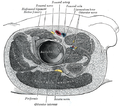- Sciatic nerve
-
Nerve: Sciatic Nerve 
Latin nervus ischiadicus Gray's subject #213 960 Innervates Lateral rotator group (except Piriformis and Quadratus femoris), Posterior compartment of thigh From lumbar plexus and sacral plexus: L4-S3 To tibial nerve, common fibular nerve The sciatic nerve (also known as the ischiadic nerve and the ischiatic nerve) is a large nerve fiber in humans and other animals. It begins in the lower back and runs through the buttock and down the lower limb. It is the longest and widest single nerve in the human body.
The sciatic supplies nearly the whole of the skin of the leg, the muscles of the back of the thigh, and those of the leg and foot. It is derived from spinal nerves L4 through S3. It contains fibres from both the anterior and posterior divisions of the lumbosacral plexus.
Contents
Branches
The nerve gives off articular and muscular branches.
- The articular branches (rami articulares) arise from the upper part of the nerve and supply the hip-joint, perforating the posterior part of its capsule; they are sometimes derived from the sacral plexus.
- The muscular branches (rami musculares) are distributed to the following muscles of the lower limb: biceps femoris, semitendinosus, semimembranosus, and adductor magnus. The nerve to the short head of the biceps femoris comes from the common fibular part of the sciatic (see below), while the other muscular branches arise from the tibial portion, as may be seen in those cases where there is a high division of the sciatic nerve.
The muscular branch eventually gives off the tibial nerve and common fibular nerve, which innervates the muscles of the (lower) leg. The tibial nerve goes on to innervate all muscles of the foot except the extensor digitorum brevis (which is innervated by the common fibular nerve).
Sensory Supply
The sciatic nerve innervates the skin on the posterior aspect of the thigh and gluteal regions, as well as the entire lower leg (except for its medial aspect).
Pathology
Pain caused by a compression or irritation of the sciatic nerve by a problem in the lower back is called sciatica. Common causes of sciatica include the following low back and hip conditions: spinal disc herniation, degenerative disc disease, lumbar spinal stenosis, spondylolisthesis and piriformis syndrome.[citation needed]
Additional images
References
See also
External links
- Duke Orthopedics sciatic_nerve
- MedlinePlus Image 19503
- pelvis at The Anatomy Lesson by Wesley Norman (Georgetown University) (pelvicnerves)
- glutealregion at The Anatomy Lesson by Wesley Norman (Georgetown University) (glutealner)
- Sciatic Nerve - Cell Centered Database
This article was originally based on an entry from a public domain edition of Gray's Anatomy. As such, some of the information contained within it may be outdated.
Nerves of lower limbs and lower torso: the lumbosacral plexus (L1–Co) (TA A14.2.05–07, GA 9.948) lumbar
plexus
(L1–L4)sacral
plexus
(L4–S4)sciaticothercoccygeal
plexus
(S4–Co)Categories:- Nerves of the lower limb and lower torso
Wikimedia Foundation. 2010.





